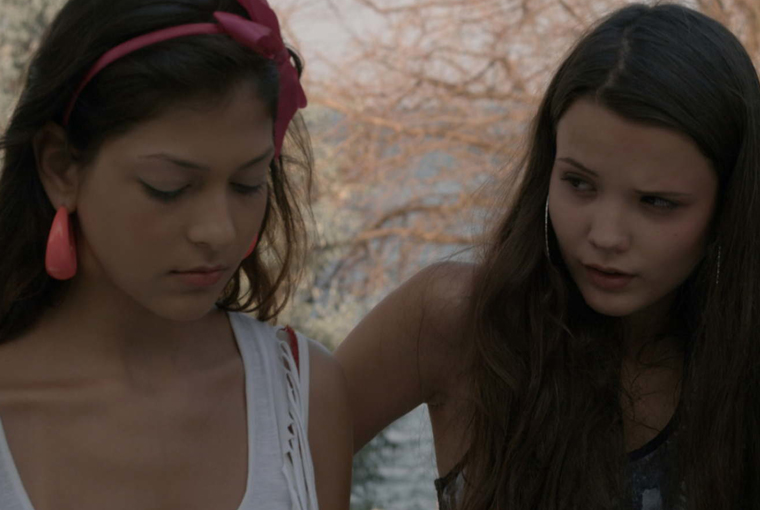Fearing Subjectivism
Nicolae Constantin Tănase’s The World Is Mine (Lumea e a mea, 2015)
Vol. 55 (July 2015) by Konstanty Kuzma
If you’ve ever visited the kitchen of a restaurant and saw the chaos and collective exertion that stands behind the seamless unity of the dishes and drinks you order, you can imagine how alienating it is for a film critic to burrow into the gruelling process that breeds artistic product. Though in theory critics know a great deal about the process of filmmaking – indeed it’s one of the three or so topics standardly broached in film-related interviews and reviews -, seeing it happen “behind the scenes” confronts them first-hand with the blatant asymmetry between the work involved in making a film and that involved in merely criticizing it. Following the inception of a film of someone you personally know is an even greater lesson in humility, since here you not only witness what effort is being put into making it, but identify with it as well. If directors often compare the filmmaking process to raising a child, you could call the critic who knows both parent and child an aunt or uncle. Sure enough this occurs rarely. But when it does, the critic must deal with the fact that the judgements he’s trying to make are impossible to rid free of his familiarity with the object of his judgements. This seems to leave the critic the choice of either refraining from a critique of the work for fear of subjectivity, or embracing subjectivity to write a review that is well-aware of its emotional and intellectual investment.
Until recently, I had thought that writing subjective critiques would be wholly beside the point, mainly because I held that against all odds art criticism should strive for aesthetic objectivity. Though I still think that this is a legitimate approach, I’m not convinced anymore that it is either definitive or wholly realistic. Indeed, it seems that much of the best criticism is appealing precisely because it offers readers an alternative way of reading a film – an angle that is inimitable and yet communicable, revolutionary but sensible. If many film discourses still seem caught up in conceptual wordplay of the sort that is impossible to disentangle, it is also true that stern sobriety, in film criticism as elsewhere, comes at a great cost. Where bad subjectivity yields obscurity, bad objectivity often yields irrelevance, sacrificing potential insight for want of lucidity. Ultimately, critics must walk the thin line between falling into a world of their own and merely reproducing what is already out there: neither should they aspire to put themselves above art, nor should they act as mere analytics.
Thus reconciled with subjective approaches to reviewing, I realize that I no longer have a pretext for not addressing the work of Nicolae Constantin Tanase, a childhood friend of mine who has been turning into a prominent voice of the post-New Wave generation of Romanian filmmakers and whose work I have been following from the very beginning of his career. Indeed, his recent debut feature, The World Is Mine, is testimony to his unswerving talent and assertiveness, though it also reminded me of the real reason why I have been reluctant to write about Nicolae’s films: if I am an uncle to his work, I have often been a bad one, as I’ve allowed genuine affection to be mitigated by the ungrateful scrutiny that marks the critic’s craft. Though I was overjoyed to hear about the considerable success of Nicolae’s debut, which won him awards at the Transilvania IFF and in Karlovy Vary, I’ve also had to concede that I was not fully convinced of its aesthetics and that many of my qualms stem from my residual penchant for objectivism.
Nicolae was trained at the Czech and Romanian national film schools, completing his education with Outrageously Disco (2009). The genre short, which has a traditional boy-meets-girl story unravel at a disco contest, marks one of the main thrusts of his earlier work (cf. Zombie Infectors 3, 2008), which aimed at ending the stylistic austerity that has dominated recent Romanian cinema since 2001. In Outrageously Disco and 12 Minutes (2013), he counters the bleak, wide-lens framing of the RNW lot with lush images and unlikely formal maturity, thus hoping to remind his viewership of the power and fun of cinema. Today, this project may no longer sound revolutionary, as directors like Iulia Rugină or Tudor Giurgiu have successfully authored audience-oriented films that have broken record after record at the domestic box office. Indeed, even auteurs such as Radu Jude or Corneliu Porumboiu have been inching closer towards an audience-friendly style with Aferim! and The Treasure (both from 2015), suggesting that the future of Romanian cinema no longer hangs on its exile existence at international film festivals.
Still a look at Nicolae’s The World Is Mine and, to a lesser extent, his short BLU (2012), both authored by Raluca Manescu, suggest that he has his own approach to winning back the audience. In BLU, a teenage girl uses the breakdown of her car as an opportunity to attract the attention of her disinterested parents – a tale in which hidden conflicts simmer behind the seamless and mundane -, and it’s this cry for attention that is later answered in The World Is Mine as Raluca and Nicolae center their attention on 16-year-old Larisa (Ana Maria Guran), another troubled teenager. Where BLU still resonated with the observational patience of contemporary Romanian cinema, The World Is Mine fully adopts the youthful obstinacy that goes with its subject. Set in a nameless seaside town and featuring a marvelous half-professional cast, the film follows Larisa’s rise and fall as she struggles to become the talk of town – an approach that is both more stern than the mainstream schemes of Giurgiu and Rugina and less arcane than the films of Porumboiu and Jude. Importantly, The World is Mine addresses a generation that has been neglected, if not forgotten by most contemporary Romanian filmmakers.
The film sets off as a love story: Larisa is in love with Florin (Florin Hritcu), the local playboy, and initially things seem to be going in their favor. An early scene has the two exchange passionate kisses that reek with sexual energy, a first taste of the depth to which the film pursues its youthful intuitions. No such euphoria is visible at home, however, where Larisa and her mom frequently argue over Larisa’s grandmother who’s sick and needs to be tended to, a responsibility only Larisa appears to take seriously. Larisa’s only support comes from her best friends (Oana Rusu, Ana Vatamanu), with whom she spends afternoons by the seaside – intimate and cleverly constructed scenes which establish the fragile footing of Larisa’s identity. Shortly after the strong bond between Larisa and her friends is established, it is put to a first test when Larisa gets into trouble with school bully Ana (Iulia Ciochina). The rival lover/girlfriend hears about Larisa’s affair with Florin and wants her to subdue, but Larisa hits back and catapults herself into serious trouble. It turns out that Ana is not only the school bully, but also the daughter of an important man who has everyone submit to his will… except for Larisa. Threatened by her father to apologize to Ana or else suffer (further) abuse, a subsequent visit to the principal’s office still has Larisa go at Ana after she gets fed up with listening to Ana’s lies and the principal’s servile compliance.
Larisa is tough and outgoing, a daring character who exacts identification as much as she tests it, and few viewers will manage to stay indifferent towards her throughout the film: if her story is one of victimization, Larisa meets all of her hurdles head-on, only relenting when it’s already too late. But she’s also delusional and partly responsible for the situation she gets herself into, and it’s painful to see Larisa get herself ever deeper into trouble. “When will you grow up?,” one of Larisa’s friends asks, a recurring question that underscores the growing alienation between Larisa and her environment.
After the incident at the principal’s office, Larisa’s on the run from both the police and her father. She visits Florin and they have sex, a commodified experience that’s devoid of the romantic involvement that Larisa’s seeking. Still, Larisa boasts with having lost her virginity in front of her friends, and when she describes the macho Florin as tender and passionate, the audience realizes that Larisa’s gradually losing her grip of reality, a feeling that is intensified by the recurrence of dream-like sequences. Yet she must learn that she’s not wanted by Florin, either, who concedes in an impressive and prosaic scene that he doesn’t want to see her again. A much-awaited party at the end of the film is a condensation of the film’s structure, as the growing divergence of reality and perception once again results in reality lashing back at Larisa in an unexpected way…
The film’s assertive style contrasts starkly with regular arthouse directors, who tend to keep their visual vocabulary to the bare minimum. Nicolae and his DP Daniel Koshut alter minimalism with handheld sequences, slow-motion and special effects, while the score features famous “Manele” songs, a pop genre whose lyrics revolve around sex and money. As mentioned above, Jude and Porumboiu have proven themselves that Romanian cinema can become more entertaining while still remaining thought-provoking, and there’s no reason why this should not be the case with younger audiences and a “younger” style.
That said, Nicolae demands immense investment from the viewer, and it is unclear whether his is the best approach to facilitating it. Daniel’s cinematography is exemplary for the way the film zooms in on Larisa, seldom giving the viewer breathing space to dwell on other characters, the interiors, or even the sea. It’s hardly surprising that the best scenes – at the car wash, the principal’s office or the multitasking ones at home – are scenes in which the viewer is given a perspective of the bigger picture, the different narrative layers that explain and constitute Larisa’s plight. Note that this is not about a lack of complexity or insight: the film is perfectly intelligent as it is, and clearly its subjectivism is intentional. The issue is that I could not identify with Larisa because the film never allowed for an outside perspective of her. To me, the film lacked traction, a point of access that would let Larisa’s world become mine as well, and though it may sound paradoxical, I feel that this lack of context ultimately hollowed out her inner self. People aren’t only made up of selves, I want to retort, and it’s worth deliberating whether trying to identify with each other’s isolated selves is the best way to counter loneliness.




Leave a Comment